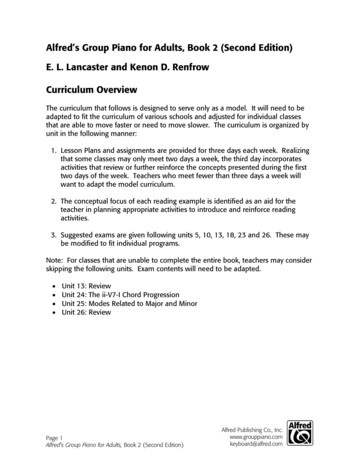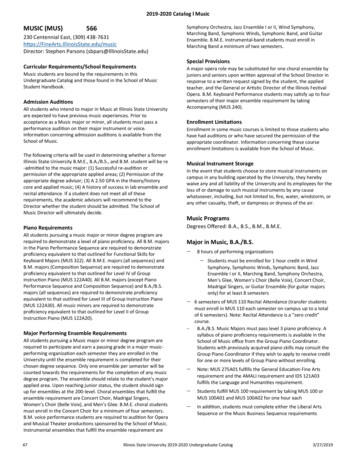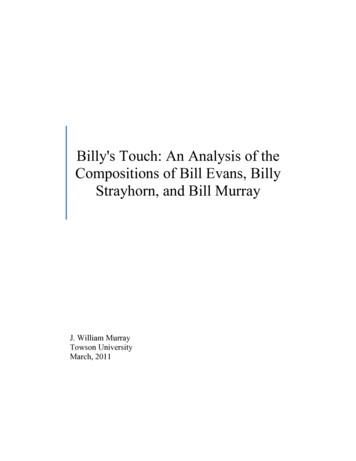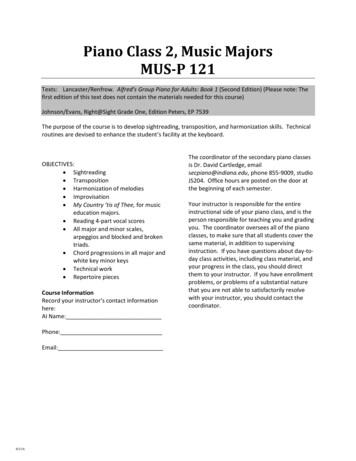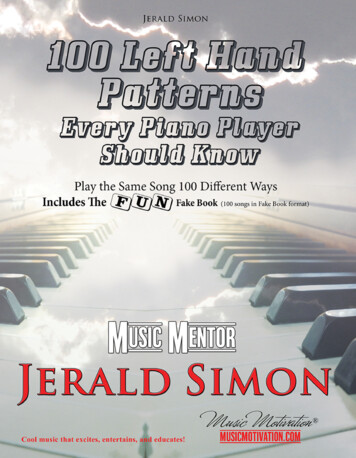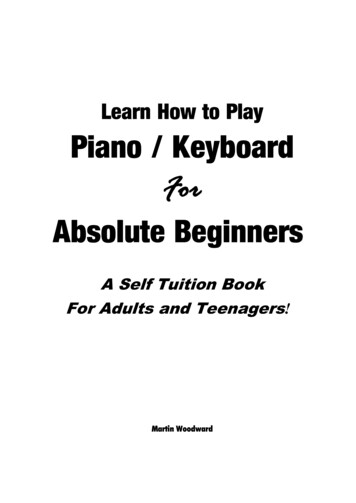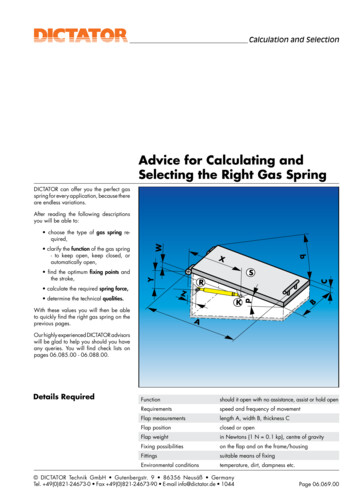
Transcription
Arizona State UniversityHerberger Online LearningBeginning Piano (MUS 145, Spring Session C) SyllabusPart 1: Course InformationInstructor InformationInstructor: Professor Hannah Creviston (W255), Class Piano Program CoordinatorOffice: ASU School of MusicOffice Telephone: (480) 965-3823E-mail: hannah.creviston@asu.eduCourse DescriptionThe Piano I Online Course introduces students to the fundamentals of piano playing, includingtechnique, solo repertoire, transposition, harmonization, sight-reading, improvisation and basicmusic theory.PrerequisiteThere are no prerequisite courses required for this course. However, students must besophomores or above to enroll in this course.Course OverviewBeginning Piano (Spring Session C) is a 16-week course delivered entirely online that isstructured into 3 units and 16 lessons as outlined in this syllabus. The course features videolectures presented by the Instructor, practice assignments for piano technique and repertoire,lesson quizzes for music terms and theory and lesson assessments in which students arerequired to upload videos of performed piano assignments. Expectations are that students willpractice their assignments on their own and use the online discussion board for introductionsand general discussion about assignments and progress. Students are also required to complete: 6 concert reviews and reports, 2 in each unit, as specified in the course outline of thissyllabus.A performance exam for each unit (3 total exams) by performing a piece of music asspecified in the course outline of this syllabus.Textbook & Course MaterialsRequired TextAdult Piano Adventures: All-in-one Lesson Book 1, (2016), Faber, Nancy and Randall. ISBN: 978-161677-302-1Required Materials Acoustic Piano or 88-Key Electric Piano (Weighted Key recommended)PedalVideo RecorderCourse Requirements Internet connection (DSL, LAN, or cable connection desirable)Access to ASURITE and to the Herberger Online Learning Management SystemPage 1
Beginning Piano Online CourseSemester SyllabusPart 2: Student Learning OutcomesHigh-level Learning Outcomes Learn and perform beginning level repertoire, demonstrating understanding of proper handposition and fingering, articulations, dynamics, phrasing and pedaling. Perform piano technique exercises, including major and minor 5-finger patterns, selectedmajor scales, hand-over-hand major and minor arpeggios and I-IV-I-V7-I chord progressionin selected major keys. Demonstrate an understanding of basic music theory and music-reading skills through sightreading, transposition, improvisation and harmonization.Course Learning Objectives Define basic music terms and demonstrate knowledge of the associated music theory. Perform piano technique of selected major and minor 5-note patterns beginning on whitekeys, hands together in rhythmic patterns; selected major scales beginning on white keys,hands separately one octave; and hand-over-hand major and minor arpeggios beginning onwhite keys. Play major triads in root position and inversions and play I-IV-I-V7-I chord progression inselected major keys. Transpose selected repertoire. Harmonize selected melodies of familiar tunes by ear using the primary chords in majorkeys. Sight-read selected repertoire. Improvise melodies with teacher accompaniment and melodies over a given chordprogression. Complete specified concert reviews. Play specified pieces of music for an audience.Course CompletionYou will meet the course objectives listed above through a combination of the following: View all video lectures presented by the Instructor accessed through the Classroom tab inthe online course. Practice all assignments using the Adult Piano Adventures: All-in-one Lesson Book 1 andidentified through the Classroom tab in the online course. Complete all lesson quizzes accessed through the Assessment tab in the online course. Complete all lesson assessments using the Adult Piano Adventures: All-in-one Lesson Book 1by uploading videos of your performed piano assignments identified in the Assessment tabin the online course. Complete 6 concert reviews and reports, 2 in each unit, as specified in the course outline ofthis syllabus. Complete a performance exam for each unit by performing a piece of music as specified inthe course outline of this syllabus.Page 2
Arizona State UniversityHerberger Online LearningPart 3: Course Outline/ScheduleCourse OutlineThe course is organized into the units, lessons, concert reports, and final exams shown below.Unit 1: Introduction to the Piano & StaffLesson 1: Introduction to PlayingLesson 2: Orientation to the StaffLesson 3: Reading ReinforcementLesson 4: More About Staff ReadingLesson 5: More Bass Clef Note ReadingConcert Review 1: Listen to a Pre-recorded Performance Chosen by the InstructorConcert Review 2: Attend, Live-stream or Listen to a Classical Solo Piano RecitalPerformance Exam: Improvise a Piece in C Five-Finger PositionUnit 2: Focus on ReadingLesson 6: Eighth (8th) NotesLesson 7: Treble Space Notes: F-A-C-ELesson 8: Treble C PentascaleLesson 9: G PentascalesLesson 10: Sharps and FlatsLesson 11: Intervals: 4ths, 5ths, 6thsConcert Review 1: Listen to a Pre-recorded Performance Chosen by the InstructorConcert Review 2: Attend, Live-stream or Listen to a Classical Solo Piano RecitalPerformance Exam: Perform a Memorized Piece of Music for an Audience (Instructor’s Choice)Unit 3: Scales and ChordsLesson 12: The C Major ScaleLesson 13: The G7 ChordLesson 14: Primary Chords in C MajorLesson 15: The G Major ScaleLesson 16: Primary Chords in G MajorConcert Review 1: Listen to a Pre-recorded Performance Chosen by the InstructorConcert Review 2: Attend, Live-stream or Listen to a Classical Non-Piano RecitalPerformance Exam: Perform an Approved Memorized Piece of Music for an Audience (Student’sChoice), and Play a Piece of Music by Ear (Instructor’s Choice)Page 3
Beginning Piano Online CourseSemester SyllabusCourse ScheduleThe tables below show the Spring 2019 Session A schedule for the course. All open times are12:00AM and close times 11:59PM unless otherwise noted.Unit 1: Introduction to the Piano & StaffTitleOpenCloseQuiz: Lesson 1Video Submission: Lesson 1Quiz: Lesson 2Video Submission: Lesson 2Quiz: Lesson 3Video Submission: Lesson 3Quiz: Lesson 4Video Submission: Lesson 4Quiz: Lesson 5Video Submission: Lesson 5Concert Review #1Concert Review #2Performance Exam 9/20194/26/2019Unit 2: Focus on ReadingQuiz: Lesson 6Video Submission: Lesson 6Quiz: Lesson 7Video Submission: Lesson 7Quiz: Lesson 8Video Submission: Lesson 8Quiz: Lesson 9Video Submission: Lesson 9Quiz: Lesson 10Video Submission: Lesson 10Quiz: Lesson 11Video Submission: Lesson 11Concert Review #3Concert Review #4Performance Exam #2Unit 3: Scales and ChordsQuiz: Lesson 12Video Submission: Lesson 12Quiz: Lesson 13Video Submission: Lesson 13Quiz: Lesson 14Video Submission: Lesson 14Quiz: Lesson 15Video Submission: Lesson 15Quiz: Lesson 16Video Submission: Lesson 16Concert Review #5Concert Review #6Performance Exam #3Final Grades Due: 4/29/19 – 5/6/19Page 4
Beginning Piano Online CourseSemester SyllabusPart 4: Lesson ObjectivesThe lessons and their objectives of the course are outlined below. Each lesson contains a videolecture and practice assignments accessed through the Classroom tab, where you can refer tothe page numbers of Adult Piano Adventures: All-in-one Lesson Book 1 for practice assignments.Refer to the announcements and schedule on the Home page for the unit/lesson deadlines.Unit 1: Introduction to the Piano & StaffLesson 1: Introduction to Playing Sit at the piano with proper posture and hand position. Identify finger numbers. Play on the two black key and three black key groups. Identify and play white key notes on the piano. Read basic rhythmic notation. Play the C Major 5-finger pattern. Play the required repertoire with proper fingering, notes, rhythm and musicality. Define given music terms and demonstrate knowledge of the associated music theory.Lesson 2: Orientation to the Staff Play the G Major 5-finger pattern. Read line and space notes on both the treble and bass clefs on the grand staff. Identify the pedals on the piano and their functions, and demonstrate proper foot positions. Play the required repertoire with proper fingering, notes, rhythm and musicality. Define given music terms and demonstrate knowledge of the associated music theory.Lesson 3: Reading Reinforcement Play the F Major 5-finger pattern. Play C, G, and F Major hand-over-hand arpeggios. Demonstrate knowledge of dynamics. Compose a short piece. Improvise using the C 5-finger pattern. Play the required repertoire with proper fingering, notes, rhythm and musicality. Define given music terms and demonstrate knowledge of the associated music theory.Lesson 4: More About Staff Reading Play D, A and E Major 5-finger patterns and arpeggios. Demonstrate knowledge of reading skips on the staff. Demonstrate knowledge of reading quarter, half and whole rests. Play the required repertoire with proper fingering, notes, rhythm and musicality. Define given music terms and demonstrate knowledge of the associated music theory.Lesson 5: More Bass Clef Note Reading Play C and G Major I-IV-I-V7-I chord progressions. Identify white key notes (Bass C – Treble F) on the piano and on the staff. Compose a short piece. Play the required repertoire with proper fingering, notes, rhythm and musicality. Define given music terms and demonstrate knowledge of the associated music theory.Page 5
Beginning Piano Online CourseSemester SyllabusUnit 2: Focus on ReadingLesson 6: Eighth (8th) Notes Play Db, Ab and Eb Major 5-finger patterns and arpeggios. Play D Major I-IV-I-V7-I chord progression. Demonstrate knowledge of reading and playing eighth (8th) notes. Choose and play a piece by ear. Play the required repertoire with proper fingering, notes, rhythm and musicality. Define given music terms and demonstrate knowledge of the associated music theory.Lesson 7: Treble Space Notes: F-A-C-E Play F Major and Bb Major I-IV-I-V7-I. Play and read treble space notes F-A-C-E. Play the required repertoire with proper fingering, notes, rhythm and musicality. Define given music terms and demonstrate knowledge of the associated music theory.Lesson 8: Treble C Pentascale Play and read the notes of a treble C pentascale. Play the required repertoire with proper fingering, notes, rhythm and musicality. Define given music terms and demonstrate knowledge of the associated music theory.Lesson 9: G Pentascales Play A Minor 5-finger pattern, arpeggios, and i–iv–i–V7-i chord progression. Play bass and treble clef G pentascales. Read and play Gsus4 chord. Play the required repertoire with proper fingering, notes, rhythm and musicality. Define given music terms and demonstrate knowledge of the associated music theory.Lesson 10: Sharps and Flats Play D and E Minor 5-finger patterns, arpeggios, and i–iv–i–V7-i chord progressions. Demonstrate knowledge of reading and playing sharps. Demonstrate knowledge of reading and playing flats. Demonstrate knowledge of reading and playing naturals. Play the required repertoire with proper fingering, notes, rhythm and musicality. Define given music terms and demonstrate knowledge of the associated music theory.Lesson 11: Intervals: 4ths, 5ths, and 6ths Play C Minor 5-finger pattern, arpeggio, and i–iv–i–V7-i chord progression. Demonstrate knowledge of reading and playing 4ths. Demonstrate knowledge of reading and playing 5ths. Demonstrate knowledge of reading and playing 6ths. Demonstrate knowledge of reading and playing blocked and broken intervals. Play the required repertoire with proper fingering, notes, rhythm and musicality. Define given music terms and demonstrate knowledge of the associated music theory.Page 6
Beginning Piano Online CourseSemester SyllabusUnit 3: Scales and ChordsLesson 12: The C Major Scale Play G and F Minor 5-finger patterns, arpeggios, and i–iv–i–V7-i chord progressions. Play the C Major scale up and down using proper fingering. Play the required repertoire with proper fingering, notes, rhythm and musicality. Define given music terms and demonstrate knowledge of the associated music theory.Lesson 13: The G7 Chord Play C#, G#, and F# Minor 5-finger patterns and arpeggios. Play a piece by ear using blocked and broken chords. Play the required repertoire with proper fingering, notes, rhythm and musicality. Define given music terms and demonstrate knowledge of the associated music theory.Lesson 14: Primary Chords in C Major Review and play C Major i–iv–i–V7-i chord progression. Demonstrate knowledge of reading and playing accidentals. Demonstrate knowledge of reading and playing from a lead sheet. Play the required repertoire with proper fingering, notes, rhythm and musicality. Define given music terms and demonstrate knowledge of the associated music theory.Lesson 15: The G Major Scale Play the G Major scale up and down using proper fingering. Play the required repertoire with proper fingering, notes, rhythm and musicality. Define given music terms and demonstrate knowledge of the associated music theory.Lesson 16: Primary Chords in G Major Review and play G Major I–IV–I–V7-I chord progression. Play the required repertoire with proper fingering, notes, rhythm and musicality. Define given music terms and demonstrate knowledge of the associated music theory.Page 7
Beginning Piano Online CourseSemester SyllabusPart 5: Course AssessmentsGraded AssessmentsThe grading for this course will be determined through lesson quizzes, lesson repertoire, unitconcert reports, and unit final exams. There are 1000 total possible points in the course, whichare shown in the Assessment Scoring section below. These assessments are accessed throughthe Assessments tab in the course.Lesson QuizzesEach lesson in the course contains a quiz with term matching and music theory questions,including ear training and piano technique exercises with graphics and audio recordings. Eachquiz is worth 10 points for a course total of 160 possible points.Lesson RepertoireEach lesson contains piano pieces that the student must play, digitally record, upload, andprovide the video link in the course website. The student will be directed to the specificassignments and page numbers contained in the Adult Piano Adventures: All-in-one Lesson Book1. The piano pieces for each lesson are worth 35 points for a course total 560 possible points,and the student is given directions for how to upload and submit their videos. The pieces in thevideo will be assessed according to five criteria: (1) Notes; (2) Rhythm/Tempo; (3) Continuity; (4)Technique; (5) Musicality.Unit Concert ReportsThe course contains 6 concert review assignments, 2 in each unit. For each concert, the studentmust complete the associated concert report form. Each report is worth 20 points for a possiblecourse total of 120 possible points.Unit Final ExamsThe student will complete a final exam in each unit by performing and videotaping specifiedpieces of music for an audience. The three final exams are worth a possible course total of 160points as shown in the tables below.Assessment ScoringBelow are the graded assessments and number of points you will receive for each completion.Refer to the Home page for the dates these assessments are open and to the page numbers ofAdult Piano Adventures: All-in-one Lesson Book 1 below for the student video assessments.Unit 1 Assessments: Introduction to the Piano & StaffLesson 1: Introduction to PlayingLesson 1 Quiz: Music Terms and TheoryStudent Video: Upload a video of yourself playing the following: Amazing Grace: With Teacher Duet as written (page 12, Teacher Duet audio) Amazing Grace: With Teacher Duet transposed to white keys (page 12) Camptown Races: With Teacher Duet (page 15, Teacher Duet audio) C 5-finger Pattern (Lecture) Merrily We Roll Along: Alone (page 19 and 21) Ode to Joy: Alone (pages 24-25) Ode to Joy: With Teacher Duet (pages 24-25, Teacher Duet audio)Lesson 2: Orientation to the StaffLesson 2 Quiz: Music Terms and TheoryPage 8Points103510
Beginning Piano Online CourseSemester SyllabusStudent Video: Upload a video of yourself playing the following: G 5-finger Pattern (Lecture) Yankee Doodle: Alone or with Teacher Duet (page 32, Teacher Duet audio) Row, Row, Row Your Boat: Alone (page 33) Catch a Falling Star: Alone as written (page 35) Catch a Falling Star: Alone transposed to G (page 35) Russian Folk Song: Alone (pages 36-37) Midnight Ride: Alone (pages 38-39)Lesson 3: Reading ReinforcementLesson 3 Quiz: Music Theory, ImprovisationStudent Video: Upload a video of yourself playing the following: F 5-finger Pattern (Lecture) C, G, and F Arpeggios (Lecture) Chant of the Monk: Alone as written (page 43) Chant of the Monk: Alone transposed to G (page 43) Composition Project (Lecture, Create Your Own Piece) Shining Stars: Alone (pages 44-45) Shining Stars: With Teacher Duet (pages 44-45, Teacher Duet audio) Roman Trumpets: Alone (pages 46-47) Roman Trumpets: With Teacher Duet (pages 46-47, Teacher Duet audio) Improvisation: Make up your own melody with Teacher Duet audio (Lecture)Lesson 4: More About Staff ReadingLesson 4 Quiz: Music Terms and Theory, Ear TrainingStudent Video: Upload a video of yourself playing the following: D, A, and E 5-finger Patterns (Lecture) D, A, and E Arpeggios (Lecture) Camptown Races: Alone (pages 44-45) Eine Kleine Nachtmusik: Alone (pages 52-53) New World Symphony Theme: Alone (page 54) New World Symphony Theme: With Teacher Duet (page 54, Teacher Duet audio) Jingle Bells: Alone (page 57) Royal Procession: Alone (page 58-59)Lesson 5: More Bass Clef Note ReadingLesson 5 Quiz: Music Terms and Theory, Ear TrainingStudent Video: Upload a video of yourself playing the following: C and G Major i–iv–i–V7-i Chord Progressions (Lecture) Bass Clef Melodies (pages, 62-63, choose two) “Surprise” Symphony: Alone (page 64) Hungarian Dance: Teacher Duet (page 65, Teacher Duet audio) Shepherd’s Song: Alone (page 66-67)Concert Review and ReportsConcert Review 1: Listen to a Pre-recorded Performance Chosen by the InstructorConcert Review 2: Attend, Live-stream or Listen to a Classical Solo Piano RecitalFinal ExamImprovise a Piece in C Five-Finger PositionUnit 1 Total PointsPage 935103510351035202045310
Beginning Piano Online CourseSemester SyllabusUnit 2 Assessments: Focus on ReadingPointsthLesson 6: Eighth (8 ) NotesLesson 6 Quiz: Music Terms and TheoryStudent Video: Upload a video of yourself playing the following: Db, Ab, and Eb 5-Finger Patterns (Lecture) Db, Ab, and Eb Arpeggios (Lecture) D Major i–iv–i–V7-i Chord Progression (Lecture) French Minuet: With Teacher Duet (page 71, Teacher Duet audio) Morning: Alone (pages 72-73) Happy Birthday Alone (page 75) English Folk Song: Alone (page 76) Gavotte: Alone (page 77) Simple Gifts: With Teacher Duet (page 79, Teacher Duet audio) Choose and Play a Piece by Ear (on your own)Lesson 7: Treble Space Notes: F-A-C-ELesson 7 Quiz: Music Theory, Ear Training, ImprovisationStudent Video: Upload a video of yourself playing the following: F and Bb Major i–iv–i–V7-i Chord Progression (Lecture) Moon on the Water: With Teacher Duet (pages 82-83, Teacher Duet audio) 500-Year-Old Melody: Alone (pages 84-85) Reveille: Alone (pages 86-87) Reveille: With Teacher Duet (pages 86-87, Teacher Duet audio) Improvisation w/Treble Space Notes: Teacher Duet (page 89, Teacher Duetaudio)Lesson 8: Treble C PentascaleLesson 8 Quiz: Music Terms and Theory, Imitative Study, Ear TrainingStudent Video: Upload a video of yourself playing the following: 3-Minute Technique: Imitative Study (page 94) May Dance: Alone (page 90) When the Saints Go Marching In: With Teacher Duet (page 91, Teacher Duetaudio) African Celebration: Alone (page 92)Lesson 9: G PentascalesLesson 9 Quiz: Music Terms and Theory, Ear TrainingStudent Video: Upload a video of yourself playing the following: A Minor 5-finger Pattern (Lecture) A Minor Arpeggio (Lecture) A Minor i–iv–i–V7-i Chord Progression (Lecture) G Pentascale Warm-up 1, 2, and 3 (page 97) Musette (page 98) Musette: Alone (page 98) American Fiddle Tune: Alone (as written and transposed to C) (page 99) Theme by Mozart: With Teacher Duet (page 100-101, Teacher Duet audio) 3-Minute Technique: Finger Fanfare: Alone (page 102)Lesson 10: Sharps and FlatsLesson 10 Quiz: Music TermsPage 10103510351035103510
Beginning Piano Online CourseSemester SyllabusStudent Video: Upload a video of yourself playing the following: D and E Minor 5-finger Patterns (Lecture) D and E Minor Arpeggios (Lecture) D and E Minor i–iv–i–V7-i Chord Progressions (Lecture) Half-Time Band: Alone (page 105) Greensleeves: With Teacher Duet (pages 106-107, Teacher Duet audio) Romance: With Teacher Duet (pages 108-109, Teacher Duet audio) Sleeping Beauty Waltz: Alone (pages 110-111)Lesson 11: Intervals: 4ths, 5ths, 6thsLesson 11 Quiz: Music Terms and Theory, Ear TrainingStudent Video: Upload a video of yourself playing the following: C Minor 5-finger Pattern (Lecture) C Minor Arpeggio (Lecture) C Minor i–iv–i–V7-i Chord Progression (Lecture) 3-Minute Technique: Hands Together Interval Study (page 126) Promenade: Alone (page 117) Chinese Kites: Alone (page 118) Danny Boy: Alone (page 119) Aria: Alone (page 121) The Lion Sleeps Tonight: With Teacher Duet (page 123, Teacher Duet) Nobody Knows the Trouble I’ve Seen: With Teacher Duet (page 124, Duet audio)Concert Review and ReportsConcert Review 3: Listen to a Pre-recorded Performance Chosen by the InstructorConcert Review 4: Attend, Live-stream or Listen to a Classical Solo Piano RecitalFinal ExamPerform a Memorized Piece of Music for an Audience (Instructor’s Choice)Unit 2 Total PointsUnit 3 Assessments: Scales and Chords351035202055365PointsLesson 12: The C Major ScaleLesson 12 Quiz: Music Theory, Ear TrainingStudent Video: Upload a video of yourself playing the following: F and G Minor 5-finger Patterns (Lecture) F and G Minor Arpeggios (Lecture) F and G Minor i–iv–i–V7-i Chord Progressions (Lecture) C Major Scale in Parallel and Contrary Motion (Lecture) Vive la France! With Teacher Duet (page 130, Teacher Duet audio) Scale Waltz: Alone (page 132)Lesson 13: The G7 ChordLesson 13 Quiz: Music Terms and Theory, Ear TrainingStudent Video: Upload a video of yourself playing the following: C# Minor, F# Minor, and G# Minor 5-finger Patterns (Lecture) C# Minor, F# Minor, and G# Minor Arpeggios (Lecture) Trumpet Voluntary: With Teacher Duet (page 135, Teacher Duet audio) Can-Can: Alone (pages 136-137)Page 1110351035
Beginning Piano Online CourseSemester Syllabus Ice Skaters: Alone (pages 138-139) Choose and Play a Piece by Ear (on your own, blocked chords, broken chords)Lesson 14: Primary Chords in C MajorLesson 14 Quiz: Music Terms and TheoryStudent Video: Upload a video of yourself playing the following: Rise and Shine: Alone (page 145) Trumpet Concerto: Alone (pages 146-147) The Entertainer: Alone (pages 148-149) Home on the Range: Alone (pages 150-151)Lesson 15: The G Major ScaleLesson 15 Quiz: Music Terms and Theory, Ear TrainingStudent Video: Upload a video of yourself playing the following: G Major Scale in Parallel and Contrary Motion (page 155, Lecture) Minuet in G: Alone (pages 156-157)Lesson 16: Primary Chords in G MajorLesson 16 Quiz: Music Terms and Theory, Ear TrainingStudent Video: Upload a video of yourself playing the following: Alexander March: Alone (page 161) Amazing Grace: With Teacher Duet (pages 162-163, Teacher Duet audio) French Dance: Alone (page 165) Polovtsian Dance: With Teacher Duet (pages 166-167. Teacher Duet audio) For He’s a Jolly Good Fellow: Alone (pages 168-169) The Carnival of Venice: Alone (pages 174-175) Improvisation with Teacher Duet (page 173, Teacher Duet audio)Concert Review and ReportsConcert Review 5: Listen to a Pre-recorded Performance Chosen by the InstructorConcert Review 4: Attend, Live-stream or Listen to a Classical Non-Piano RecitalFinal ExamPerform an Approved Memorized Piece of Music for an Audience (Student’s Choice)Play a Piece of Music by EarUnit 3 Total PointsCourse Total PointsPage 12103510351035202030303251000
Beginning Piano Online CourseSemester SyllabusAssessment PoliciesQuizzesYou need to have reliable access to the Internet on the assigned days of the lesson quizzesbecause they can only be completed online. Submission of quizzes via email or in printed formwill not be accepted. No exceptions. The use of smart phones for taking a quiz is forbidden. Noother Web pages or tabs can be open while taking a quiz. The system logs all browser activity.Opening new browsers or new browser tabs can invalidate your testing session. Do not giveyour unique course password to another person or allow another person to access the course totake the test in your name.Submitting Online QuizzesOnline quizzes that have been submitted CANNOT be reset (see below). IF you experiencecomputer or technical problems during an online quiz, DO NOT SUBMIT the quiz. If you suspecttechnical error, exit the browser immediately and address the problem by trying to take the quizagain on a different computer, or by contacting technical support at HOLSupport@asu.edu. Donot contact the instructor. Submitted quizzes cannot be retaken. No exceptions.Resets for Online QuizzesA reset for an online quiz is an action usually taken by a student prior to contacting technicalsupport. IF you experience a glitch during an online quiz, close your browser. When you attemptto restart the online quiz, the system will ask you to confirm the reset. Important about resets: Only one online reset is allowed per each online quiz. In total, only two online resets on online quizzes are allowed in any given semester.Concert ReviewsYou are required to complete 6 concert reviews in the course, and to fill out and submit aConcert Report for each concert. You will be able to access the Concert Report Form from theAssessments tab in the course. Type your answers in complete sentences and read all theConcert Attendance Guidelines before attending a live performance.Concert Attendance Guidelines Please arrive early to each recital/concert. If you are late for some reason, do not enter thehall when someone is performing. Wait until you hear applause. Turn off your cell phone and watch alarms before entering the concert hall. You are required to stay for the entire concert. Be advised that there may be anintermission at some performances. Be respectful of your fellow audience members and of the performer(s). Refrain fromtalking, rustling papers, or clicking pens. If you are writing notes for yourself, do so inbetween pieces. Applaud at the appropriate times, not in between movements. Food, drink, photography, and recording are usually forbidden.NOTE: If a student submits a concert review that has been plagiarized or for a concert that wasnot attended, a grade of XE will be recommended.Page 13
Beginning Piano Online CourseSemester SyllabusStudent VideosTo complete the student video assessments in the lessons and for the final exam, you will needto digitally record your performances and upload them to YouTube, and then provide the videolink in the course website. To upload the videos:1. Log in to YouTube using your ASU Google account (or personal account if you prefer).2. Upload the video.Note: You may choose to make the video unlisted (NOT private). Remember that yoursubmission cannot be graded if it can’t be viewed.3. Paste the link into the submission form on the course website.4. Submit your assignment.Viewing Grades in HOLMSPoints you receive for graded assessments will be posted to the Herberger Online ManagementSystem (HOLMS) Grade Book. Click on the My Grades link on the left navigation to view yourpoints. Your instructor will update the online grades each time a grading session has beencompleted. You will see a visual indication of new grades posted on your HOLMS home pageunder the link to this course.Letter Grade AssignmentFinal grades assigned for this course will be based on the percentage of total points earned andare assigned as follows:96.6 – 100 A 86.6 – 90 B 76.6 – 80 C 93.3 – 96.5 A83.3 – 86.5 B70.1 – 76.5 C90.1 – 93.2 A-80.1 – 83.2 B-60.1 – 70 D0 – 60 FPiano Performance RubricCompletion of your performed piano assignments will be assessed according to these equallyweighted alityAccurately performed notes from the scoreAccurately performed rhythms and tempo from the scoreSmoothly flowing performance without breaksProper posture, position (body, arm, hand), fingering, preparation, handliftsInclusion of musical elements including, but not limited to dynamics,articulation, pedaling, phrasing and intonationFingernail PolicyProperly trimmed fingernails are necessary for good hand posture at the piano. Students arehighly encouraged to maintain fingernails at a length that permits them to touch the keyboardwith the tips of their fingers without clicking their nails.Page 14
Arizona State UniversityHerberger Online LearningPart 6: Course
Arizona State University Herberger Online Learning Page 1 Beginning Piano (MUS 145, Spring Session C) Syllabus Part 1: Course Information Instructor Information Instructor: Professor Hannah Creviston (W255), Class Piano Program Coordinator Office: ASU School of Music Office Telephone: (480) 965
